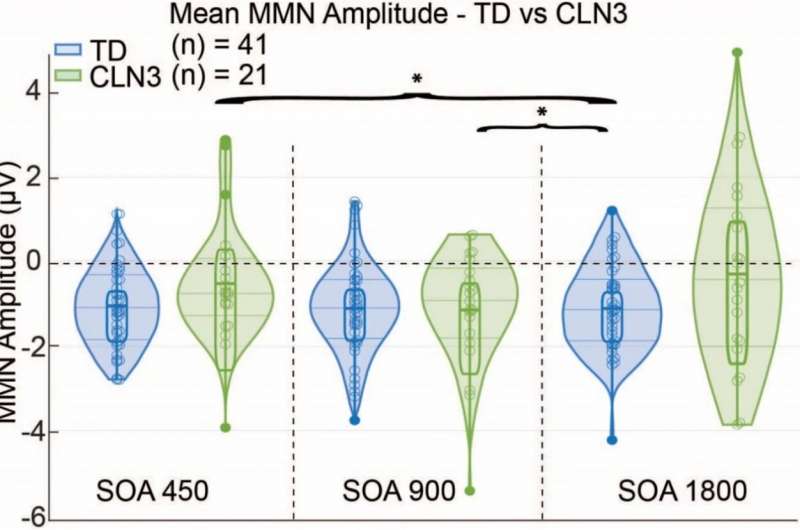This article has been reviewed according to Science X's editorial process and policies. Editors have highlighted the following attributes while ensuring the content's credibility:
fact-checked
trusted source
proofread
Researchers find possible neuromarker for 'juvenile-onset' Batten disease

Early symptoms can be subtle. A child's personality and behavior may change, and clumsiness or stumbling develops between the ages of 5 and 10. Over time, cognitive impairment sets in, seizures emerge or worsen, vision loss begins, and motor skills decline. This is the course of Batten disease, a progressive inherited nervous system disorder resulting from mutations to the CLN3 gene.
"It is a devastating neurodegenerative disorder of childhood," said John Foxe, Ph.D., director of the Del Monte Institute for Neuroscience and co-director of the University of Rochester Intellectual and Developmental Disabilities Research Center (UR-IDDRC), "and while it is very rare, it is important to study and understand because it could inform what we know and how we treat it and other related rare diseases."
A possible neuromarker
In a new study, published in the Journal of Neurodevelopmental Disorders, Foxe and a team of researchers from the University of Rochester Medical Center may be closer to that goal of understanding. The paper describes how they measured changes in brain function of participants with CLN3 disease, also known as "juvenile-onset" Batten disease.
Researchers found that the functioning of the auditory sensory memory system—the brain system required for short-term memory recall—appears to decrease as the disease progresses. They revealed this by utilizing electroencephalographic recordings (EEG) to measure participants' brain activity with and without Batten disease as they passively listened to simple auditory beeps.
The participants simultaneously watched a video of their favorite movie while the brain responses to these beeps were being measured. In the participants with Batten disease, the EEG revealed a decline in the response from the auditory sensory memory system as the disease progressed.
There were no significant changes among the other participants. This finding suggests that this easy-to-measure brain process may be a target or biomarker in measuring treatment outcomes in clinical trials.
"We needed to find a task that did not require explicit engagement or attention, and this is one of those kinds of tasks," Foxe said. "The brain produces the signal that we're looking at, regardless of whether the participant is paying attention to the beeps or not. It is an objective method that provides new insight into the brain function of a population with varying communication abilities."
There are 12 currently known childhood-onset forms of Batten disease, each genetically distinct from one another, and all significantly impact neurodevelopment. With several potential gene therapies for Batten disease currently in advanced stages of development, this recent finding continues the mission of identifying biomarkers to evaluate the effectiveness of these experimental treatments.
Progressing scientific findings
Researchers in the Frederick J. and Marion A. Schindler Cognitive Neurophysiology Lab, where Foxe is co-principal investigator with Edward Freedman, Ph.D., are using these findings to leverage a Batten disease mouse model. They aim to measure the impact pharmaceuticals have on the auditory perceptual system. Researchers are starting with treatments already on the market for other conditions.
"We think this potential biomarker is key to the possibility for us to screen these treatments in the mouse models. The auditory sensory memory marker provides a sensitive measure," Foxe said. "We'll be able to tell you pretty quickly if a treatment is having an impact and know if it is actually changing dynamics—i.e., whether the system in the brain is improving, what the speed of improvement is, etc. I think that is a big deal."
More information: Tufikameni Brima et al, Assessing the integrity of auditory sensory memory processing in CLN3 disease (Juvenile Neuronal Ceroid Lipofuscinosis (Batten disease)): an auditory evoked potential study of the duration-evoked mismatch negativity (MMN), Journal of Neurodevelopmental Disorders (2024). DOI: 10.1186/s11689-023-09515-8



















